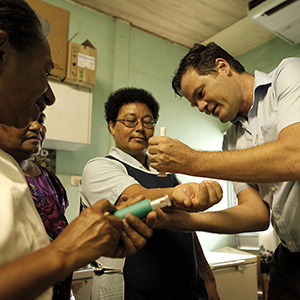Revolutionary nanotechnology set to provide solutions to inoculation issues in developing countries.
Nanotechnology? I wondered the same thing when I first heard. It’s pretty incredible really; it’s basically the study of structures at magnifications beyond what the eye can see. And using this cutting-edge science, bioengineer Mark Kendall has come up with an innovation, smaller than a human fingernail, that could replace needle delivery of vaccinations and provide the answers to some of the major problems associated with mass immunisation. Most crucially, those in developing nations.
Many of us living in the developed world now take for granted the importance of vaccines; we are lucky enough to be in a position whereby the use of inoculations on a sustained mass scale has enabled us to reach a point whereby many contagious diseases have become wiped out.
Unfortunately, these devastating and potentially fatal illnesses still ravage populations in developing countries, where there is insufficient means to vaccinate communities.
This is where the Nanopatch claims its stake in potentially becoming one of the biggest innovations in modern immunology.
The 1cm² patch takes advantage of the skin as the body’s “immune sweet spot”, according to the Australian professor responsible for this advancement. The largest organ of the human body, not only does your skin defend against pathogenic microorganisms (the little nasties that cause disease), it also homes a hotbed of immune cells beneath the surface, which the patch delivers the vaccine directly into.
The tiny silicon square is covered with around 20,000 micro-projections – imagine little spikes, so minute that they cannot be felt, nor are they visible to the human eye – which are coated with dry vaccine. When applied directly to the skin using an applicator, the spikes penetrate the outer layer and administer the antigen to the eager immune-cells waiting beneath, sparking an impressive response.
The potential of this patch is ground-breaking. Though currently in the pre-human-trial stage of development, the technology has proven extremely effectual in the mouse model. Initial results have shown the product to be 100 times as effective as its needle counter-part and can be produced at a fraction of the price. “When the device is made in sufficiently large numbers, our cost estimates are significantly less than US$1 per dose,” Kendall assures.
For 160 years now, the needle and syringe method has fronted technology of contemporary vaccination programmes and whilst it is efficient, it inevitably maintains a range of shortcomings for which this tiny innovation holds the promise of overcoming.
Of the design’s broadest achievements: no needle equals no phobias – hooray! Plus, no chance of needle injuries; no potential for disease transmission associated with needle reuse; and, no pain on vaccine delivery either. Of its most integral successes, it doesn’t require specialised staff to administer it, nor does it depend on the cold-chain to maintain it in transportation or storage – both astounding achievements in the efforts towards making vaccinations more readily available, especially in developing countries.
“Because the Nanopatch requires neither a trained practitioner to administer it nor refrigeration, it has enormous potential to cheaply deliver vaccines in developing nations,” Kendall has said. For the remoter areas of some geographic areas, the logistics of supplying a temperature-controlled product has big implications on whether communities can be provided with life-saving vaccines. In places, the presence of adequate refrigeration is limited, or non-existent and the availability of appropriately skilled staff to administer the vaccines is also restricted. Problems which the Nanopatch solve.
Not only this, but for developed countries, these epic advancements hold future possibilities of seeing vaccines becoming available from local chemists or even being mailed out to home addresses, to self-dispense.
So what’s the catch? Well, as mentioned previously, it is yet to be tested on humans. However, since initial usability tests carried out by Kendall’s team at the University of Queensland have had such remarkable results, the promise of success in human trials (set to begin later this year) is very encouraging. And even though some other patches of comparable concepts have failed to reach their potential, new company Vaxxas has claimed that it is “the applicator design (which) overcomes the inconsistency that plagues other transdermal vaccine delivery approaches.”
Professor Kendall has big aspirations for his Nanopatch. With the World Health Organization this week estimating that “around 22 million children in developing countries are still not protected from dangerous diseases with basic vaccines” the need for the success of this technology is more crucial than ever. Having won a Rolex award for his research, he has said “I have an absolute passion to deliver better vaccination to the low-resource regions of the world, without them having to wait years for it to trickle down from the developed world”.
Though it is going to take a concerted effort – pooling resources of education, funding and technology – to eradicate major vaccination issues, this tiny patch has the potential to take massive steps towards helping drastically cut the number of preventable deaths each year- all without a needle in sight.
Photo credit: University of Queensland
